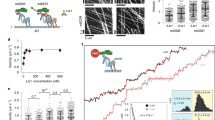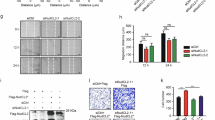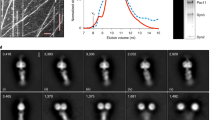Abstract
Lis1 gene defects impair neuronal migration, causing the severe human brain malformation lissencephaly. Although much is known about its interactions with microtubules, microtubule-binding proteins such as CLIP-170, and with the dynein motor complex, the response of Lis1 to neuronal motility signals has not been elucidated. Lis1 deficiency is associated with deregulation of the Rho-family GTPases Cdc42, Rac1 and RhoA, and ensuing actin cytoskeletal defects, but the link between Lis1 and Rho GTPases remains unclear. We report here that calcium influx enhances neuronal motility through Lis1-dependent regulation of Rho GTPases. Lis1 promotes Cdc42 activation through interaction with the calcium sensitive GTPase scaffolding protein IQGAP1, maintaining the perimembrane localization of IQGAP1 and CLIP170 and thereby tethering microtubule ends to the cortical actin cytoskeleton. Lis1 thus is a key component of neuronal motility signal transduction that regulates the cytoskeleton by complexing with IQGAP1, active Cdc42 and CLIP-170 upon calcium influx.
This is a preview of subscription content, access via your institution
Access options
Subscribe to this journal
Receive 12 print issues and online access
$209.00 per year
only $17.42 per issue
Buy this article
- Purchase on Springer Link
- Instant access to full article PDF
Prices may be subject to local taxes which are calculated during checkout







Similar content being viewed by others
References
Raftopoulou, M. & Hall, A. Cell migration: Rho GTPases lead the way. Dev. Biol. 265, 23–32 (2004).
Ridley, A.J. et al. Cell migration: integrating signals from front to back. Science 302, 1704–1709 (2003).
Nelson, W.J. Adaptation of core mechanisms to generate cell polarity. Nature 422, 766–774 (2003).
Kholmanskikh, S.S., Dobrin, J.S., Wynshaw-Boris, A., Letourneau, P.C. & Ross, M.E. Disregulated Rho GTPases and actin cytoskeleton contribute to the migration defect in Lis1-deficient neurons. J. Neurosci. 23, 8673–8681 (2003).
Berridge, M.J., Bootman, M.D. & Roderick, H.L. Calcium signalling: dynamics, homeostasis and remodelling. Nat. Rev. Mol. Cell Biol. 4, 517–529 (2003).
Xu, H.T. et al. Calcium signaling in chemorepellant Slit2-dependent regulation of neuronal migration. Proc. Natl Acad. Sci. USA 101, 4296–4301 (2004).
Robles, E., Huttenlocher, A. & Gomez, T.M. Filopodial calcium transients regulate growth cone motility and guidance through local activation of calpain. Neuron 38, 597–609 (2003).
Fishman, R.B. & Hatten, M.E. Multiple receptor systems promote CNS neural migration. J. Neurosci. 13, 3485–3495 (1993).
Rivas, R.J. & Hatten, M.E. Motility and cytoskeletal organization of migrating cerebellar granule neurons. J. Neurosci. 15, 981–989 (1995).
Wittmann, T. & Waterman-Storer, C.M. Cell motility: can Rho GTPases and microtubules point the way? J. Cell Sci. 114, 3795–3803 (2001).
Swart-Mataraza, J.M., Li, Z. & Sacks, D.B. IQGAP1 is a component of Cdc42 signaling to the cytoskeleton. J. Biol. Chem. 277, 24753–24763 (2002).
Weissbach, L. et al. Identification of a human rasGAP-related protein containing calmodulin-binding motifs. J. Biol. Chem. 269, 20517–20521 (1994).
Fukata, M. et al. Rac1 and Cdc42 capture microtubules through IQGAP1 and CLIP-170. Cell 109, 873–885 (2002).
Watanabe, T. et al. Interaction with IQGAP1 links APC to Rac1, Cdc42, and actin filaments during cell polarization and migration. Dev. Cell 7, 871–883 (2004).
Hirotsune, S. et al. Graded reduction of Pafah1b1 (Lis1) activity results in neuronal migration defects and early embryonic lethality. Nat. Genet. 19, 333–339 (1998).
Rossi, D.J. & Slater, N.T. The developmental onset of NMDA receptor-channel activity during neuronal migration. Neuropharmacology 32, 1239–1248 (1993).
Komuro, H. & Rakic, P. Orchestration of neuronal migration by activity of ion channels, neurotransmitter receptors, and intracellular Ca2+ fluctuations. J. Neurobiol. 37, 110–130 (1998).
LoTurco, J.J., Blanton, M.G. & Kriegstein, A.R. Initial expression and endogenous activation of NMDA channels in early neocortical development. J. Neurosci. 11, 792–799 (1991).
Monyer, H., Burnashev, N., Laurie, D.J., Sakmann, B. & Seeburg, P.H. Developmental and regional expression in the rat brain and functional properties of four NMDA receptors. Neuron 12, 529–540 (1994).
Meng, Y., Zhang, Y., Tregoubov, V., Falls, D.L. & Jia, Z. Regulation of spine morphology and synaptic function by LIMK and the actin cytoskeleton. Rev. Neurosci. 14, 233–240 (2003).
Sin, W.C., Haas, K., Ruthazer, E.S. & Cline, H.T. Dendrite growth increased by visual activity requires NMDA receptor and Rho GTPases. Nature 419, 475–480 (2002).
Schell, M.J., Brady, R.O., Jr, Molliver, M.E. & Snyder, S.H. D-serine as a neuromodulator: regional and developmental localizations in rat brain glia resemble NMDA receptors. J. Neurosci. 17, 1604–1615 (1997).
Boehning, D. & Snyder, S.H. Novel neural modulators. Annu. Rev. Neurosci. 26, 105–131 (2003).
Kim, P.M. et al. Serine racemase: activation by glutamate neurotransmission via glutamate receptor interacting protein and mediation of neuronal migration. Proc. Natl. Acad. Sci. USA 102, 2105–2110 (2005).
Komuro, H. & Rakic, P. Intracellular Ca2+ fluctuations modulate the rate of neuronal migration. Neuron 17, 275–285 (1996).
Mataraza, J.M., Briggs, M.W., Li, Z., Frank, R. & Sacks, D.B. Identification and characterization of the Cdc42-binding site of IQGAP1. Biochem. Biophys. Res. Commun. 305, 315–321 (2003).
Briggs, M.W. & Sacks, D.B. IQGAP proteins are integral components of cytoskeletal regulation. EMBO Rep. 4, 571–574 (2003).
Li, Q. & Stuenkel, E.L. Calcium negatively modulates calmodulin interaction with IQGAP1. Biochem. Biophys. Res. Commun. 317, 787–795 (2004).
Perez, F., Diamantopoulos, G.S., Stalder, R. & Kreis, T.E. CLIP-170 highlights growing microtubule ends in vivo. Cell 96, 517–527 (1999).
Schuyler, S.C. & Pellman, D. Microtubule “plus-end-tracking proteins”: the end is just the beginning. Cell 105, 421–424 (2001).
Rickard, J.E. & Kreis, T.E. CLIPs for organellemicrotubule interactions. Trends Cell Biol. 6, 178–183 (1996).
Coquelle, F.M. et al. LIS1, CLIP-170's key to the dynein/dynactin pathway. Mol. Cell. Biol. 22, 3089–3102 (2002).
Miki, H., Sasaki, T., Takai, Y. & Takenawa, T. Induction of filopodium formation by a WASP-related actin-depolymerizing protein N-WASP. Nature 391, 93–96 (1998).
Kjoller, L. & Hall, A. Signaling to Rho GTPases. Exp. Cell Res. 253, 166–179 (1999).
Waterman-Storer, C.M. & Salmon, E. Positive feedback interactions between microtubule and actin dynamics during cell motility. Curr. Opin. Cell Biol. 11, 61–67 (1999).
Palazzo, A.F., Eng, C.H., Schlaepfer, D.D., Marcantonio, E.E. & Gundersen, G.G. Localized stabilization of microtubules by integrin- and FAK-facilitated Rho signaling. Science 303, 836–839 (2004).
Messersmith, E.K., Feller, M.B., Zhang, H. & Shatz, C.J. Migration of neocortical neurons in the absence of functional NMDA receptors. Mol. Cell. Neurosci. 9, 347–357 (1997).
Meng, Y. et al. Abnormal spine morphology and enhanced LTP in LIMK-1 knockout mice. Neuron 35, 121–133 (2002).
Bashour, A.M., Fullerton, A.T., Hart, M.J. & Bloom, G.S. IQGAP1, a Rac- and Cdc42-binding protein, directly binds and cross-links microfilaments. J. Cell Biol. 137, 1555–1566 (1997).
Mateer, S.C. et al. The mechanism for regulation of the F-actin binding activity of IQGAP1 by calcium/calmodulin. J. Biol. Chem. 277, 12324–12333 (2002).
Ho, Y.D., Joyal, J.L., Li, Z. & Sacks, D.B. IQGAP1 integrates Ca2+/calmodulin and Cdc42 signaling. J. Biol. Chem. 274, 464–470 (1999).
Li, Z. & Sacks, D.B. Elucidation of the interaction of calmodulin with the IQ motifs of IQGAP1. J. Biol. Chem. 278, 4347–4352 (2003).
Wolenski, J.S. Regulation of calmodulin-binding myosins. Trends Cell Biol. 5, 310–316 (1995).
Tsai, J.W., Chen, Y., Kriegstein, A.R. & Vallee, R.B. LIS1 RNA interference blocks neural stem cell division, morphogenesis, and motility at multiple stages. J. Cell Biol. 170, 935–945 (2005).
Gasser, U.E. & Hatten, M.E. Neuron-glia interactions of rat hippocampal cells in vitro: glial-guided neuronal migration and neuronal regulation of glial differentiation. J. Neurosci. 10, 1276–1285 (1990).
Smith, D.S. et al. Regulation of cytoplasmic dynein behaviour and microtubule organization by mammalian Lis1. Nat. Cell Biol. 2, 767–775 (2000).
Assadi, A.H. et al. Interaction of reelin signaling and Lis1 in brain development. Nat. Genet. 35, 270–276 (2003).
Lansbergen, G. et al. Conformational changes in CLIP-170 regulate its binding to microtubules and dynactin localization. J. Cell Biol. 166, 1003–1014 (2004).
Acknowledgements
Supported by the US National Institute of Neurological Disorders and Stroke (RO1NS35515 to M.E.R., PO1NS39404 to M.E.R. and A.W.B.) and National Institute of Child Health and Development (RO1HD19950 to P.C.L.).
Author information
Authors and Affiliations
Corresponding author
Ethics declarations
Competing interests
The authors declare no competing financial interests.
Supplementary information
Supplementary Fig. 1
D-Serine fails to stimulate Lis1+/− neuronal migration despite enhancing Ca2+ fluctuations. (PDF 158 kb)
Supplementary Fig. 2
Bioactivity of plasmids expressing constitutively active G12V-Cdc42 (Cdc42ca) or dominant negative T17N-Cdc42 (Cdc42dn). (PDF 722 kb)
Supplementary Fig. 3
Demonstration of IQGAP1 down-regulation by shRNAi. (PDF 164 kb)
Supplementary Fig. 4
Demonstration of CLIP-170 down-regulation by shRNAi. (PDF 178 kb)
Supplementary Fig. 5
Model for Lis1 role in Ca2+ modulation of Rho GTPases and neuronal cytoskeleton. (PDF 816 kb)
Supplementary Fig. 6
Phosphorylation of Lis1 is enhanced by D-serine treatment. (PDF 147 kb)
Rights and permissions
About this article
Cite this article
Kholmanskikh, S., Koeller, H., Wynshaw-Boris, A. et al. Calcium-dependent interaction of Lis1 with IQGAP1 and Cdc42 promotes neuronal motility. Nat Neurosci 9, 50–57 (2006). https://doi.org/10.1038/nn1619
Received:
Accepted:
Published:
Issue Date:
DOI: https://doi.org/10.1038/nn1619
This article is cited by
-
Activation of RhoC by regulatory ubiquitination is mediated by LNX1 and suppressed by LIS1
Scientific Reports (2022)
-
Drebrin-mediated microtubule–actomyosin coupling steers cerebellar granule neuron nucleokinesis and migration pathway selection
Nature Communications (2017)
-
A defect in the CLIP1 gene (CLIP-170) can cause autosomal recessive intellectual disability
European Journal of Human Genetics (2015)
-
Pregnenolone activates CLIP-170 to promote microtubule growth and cell migration
Nature Chemical Biology (2013)
-
De novo mutations in the actin genes ACTB and ACTG1 cause Baraitser-Winter syndrome
Nature Genetics (2012)



